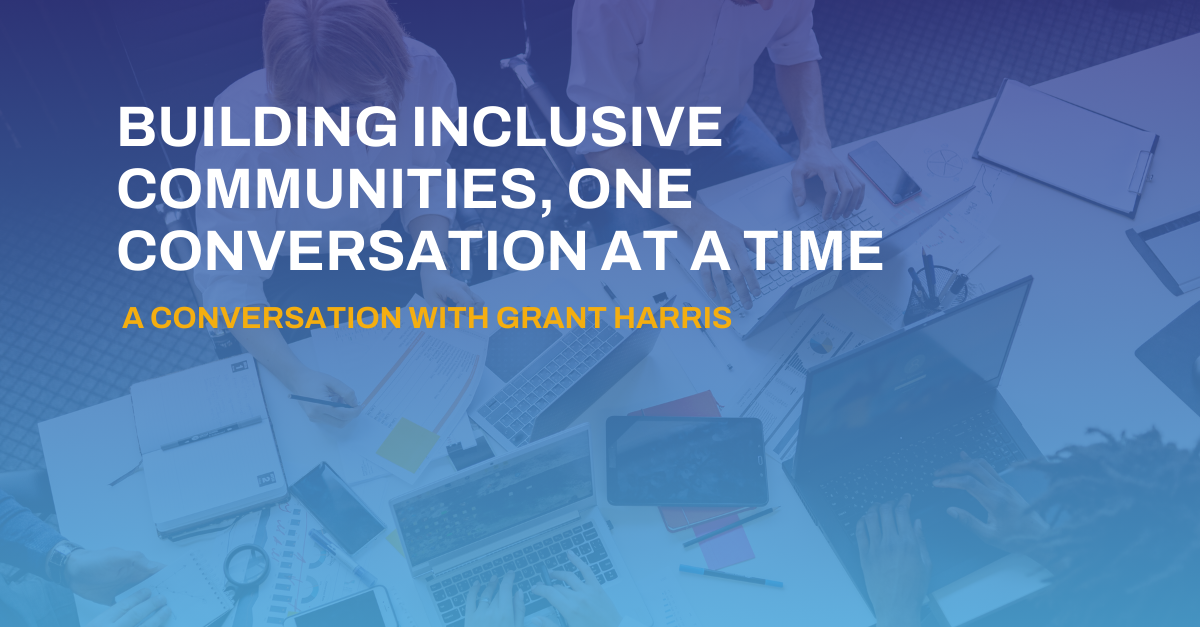Communities are everywhere—at work, in school, at home, and even in the digital spaces we inhabit daily. While some of these communities foster inclusion, others struggle to make space for everyone. So, what’s the difference between an inclusive community and one that isn’t? The answer often lies in how conversations happen and how culture is built.
Sustainable change in any community doesn’t happen with a set of rules or a checklist—it happens one conversation at a time. Conversations where we listen, engage, and recognize the lived experiences of others makes a lasting impact. This is what Grant Harris, a leading voice in organizational culture and neurodiversity, continues to teach me through our ongoing discussions. His insights have shaped my understanding of how we can move beyond temporary initiatives and build lasting, meaningful change in the workplace.
“The future is here, the future is now. Instead of talking about the future of work with inclusion/neuroinclusion, focus on the here and now. People are living now.”
Initiatives vs. Culture: A Clear Contrast
Grant is a master of bringing together multiple perspectives and summarizing complex ideas into digestible definitions and ah-ha moments. In a recent interview, he shared the idea that true inclusion is about culture change vs a series of short-term initiatives and labeled programs.
So, let’s explore how the concepts of initiatives and culture differ and why making this shift in semantics, intention, and action is essential to support each person that in turn, benefits the whole organization.
| Aspect | Initiatives | Culture |
|---|---|---|
| Definition | Temporary, short-term programs with a clear start and end date. | Long-term, ingrained practices are part of daily operations. |
| Focus | Specific events, training, or projects. | Everyday behaviors, policies, and decision-making. |
| Leadership Involvement | Often driven by specific teams, without full leadership buy-in. | Led and modeled by senior leadership, affecting all levels. |
| Employee Engagement | Seen as extra effort or temporary. | A core value of the organization, affecting daily work. |
| Impact | Short-term & may not lead to lasting change. | Long-term impact on employee satisfaction, retention, and productivity. |
| Accountability | Evaluated by completion of goals, limited follow-through. | Continuous evaluation through feedback and ongoing adaptation. |
| Tools | Narrow, one-off tools/resources. | Multi-modal, flexible tools integrated into everyday use across teams. |
| Goal | To raise awareness or temporarily address issues. | To create a sustainable, inclusive environment for all. |
Practical Tips for Leaders: Simple, Yet Impactful
Leaders play a crucial role in fostering inclusive cultures. To help leaders create inclusive environments, Grant shared some simple yet impactful advice that can transform everyday leadership practices.
1. Listen More, Speak Less
“I tell my kids all the time, you know you have two ears and one mouth, so you should listen twice as much as you speak. Now that’s a simple solution, but it’s not easy for people, especially leaders who hold power.”
2. Ask More Questions, Make Fewer Statements
“If you ask someone a question, in a curious way, in an ‘I want to learn’ kind of way, not a loaded question that you already know the answer to, then people let their guard down because they feel like you were interested in them. Ask open-ended questions like:
- How do you work best?
- What makes you tick?
- What does success mean to you?
3. Align Words & Actions
“You can say one thing and mean another. You can do one thing, and you meant for that thing to have a certain impact, but it had a completely different impact. So, the goal is to mesh them so that they are congruent and that they are aligned.”
4. Recognize the Importance of Distinction in Every Person
“I believe that all people are distinct human beings in and of themselves. And they were created distinctly. And therefore, they deserve to live a life full of distinction.”
The Future of Inclusion is Here, Now
“The future is here, the future is now. Instead of talking about the future of work with inclusion/neuroinclusion, focus on the here and now. People are living now.”
It’s clear that the path to creating inclusive communities and workplaces is not through temporary initiatives but through sustainable culture shifts. Grant’s insights help us see that inclusion must be woven into every part of an organization, starting with small, meaningful conversations that foster connection. By embracing these practices—active listening, asking the right questions, aligning words with actions, and recognizing the value in every individual—leaders can create environments where inclusion is experienced, not just stated.
The future of inclusion isn’t something to wait for—it’s happening now, in the everyday actions and conversations that define our workplace cultures.
More on Grant Harris
Grant Harris is an autistic consultant, speaker, and author. His work helps organizations harness the business value of neurodiversity in the workplace from the boardroom to the mailroom while moving ‘From Compliance to Community’™ to achieve organizational excellence.
Learn about Grant HERE and follow him on LinkedIn for tips on how to build neuroinclusive workplaces.
Cephable is a tool to support flexible, multi-modal technology that adapts to diverse needs.
Subscribe to Our Newsletter
Subscribe to our InkSights newsletter for updates, the latest innovations in AT, community announcements, and more!

